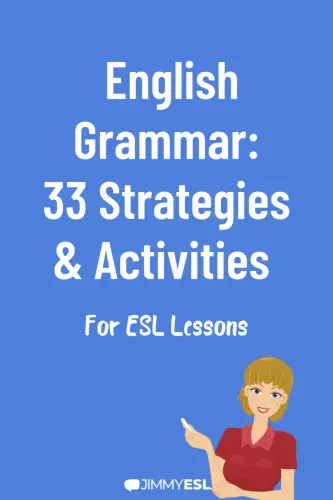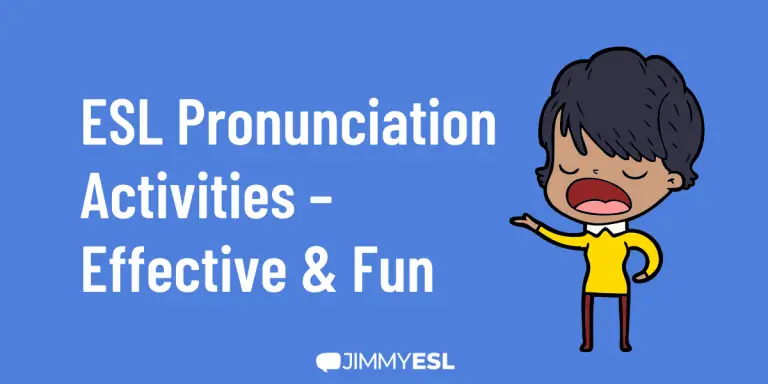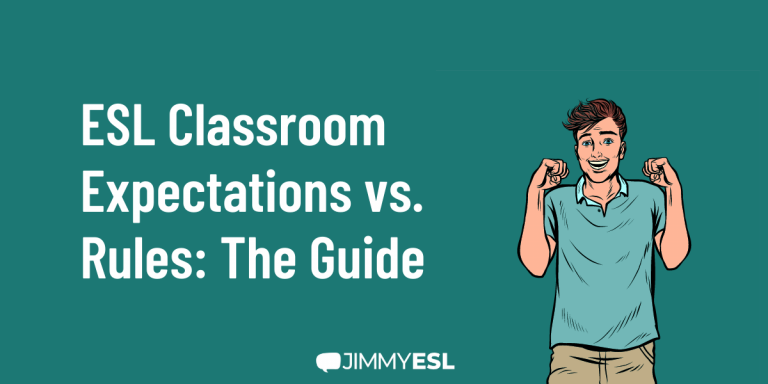33 Sure-Fire Strategies & Activities for Teaching English Grammar
Grammar… how do we teach it?
Is it just reciting monotonously from a textbook and hoping that the students are on board?
Can we make it more interactive and dare I say, even fun?
Read on and find out yourself!
Whether you’re new to teaching English (ESL) or are just looking for new ways to keep things fresh in the classroom, there is something in this guide about teaching grammar for everyone.
After using some of these 33 strategies and activities, don’t be surprised if you’re soon being harassed by other teachers who want to know your secrets!
Why Inspiring Grammar Lessons Are So Important
Grammar in any language is important, that’s a fact and English grammar is no exception. Learning grammar can be no easy task and teaching it can be even harder!
There are a number of reasons that can make teaching grammar a difficult task, including fossilized errors, irregularity of verbs, plurals, etc and vast differences between English and the student’s mother tongue.
Another issue can come from the mindset of the students. If they have experienced dry, boring grammar lessons in the past then they will likely expect the same this time around.
It is important for you to break the mold and allow your great grammar lessons to captivate and inspire your ESL students to get the best results from them.
So… How do we do this?
7 Sure-Fire Strategies and Survival Tips for Your Grammar Lessons
Let’s have a look at some “survival tips” to help you and your students navigate the jungle that is English grammar.
1. Teaching Grammar in Context
One method of teaching which has had a lot of success is teaching grammar in context.
This makes sense as we created “grammar rules” as a way to make sense of the patterns that we use in the language. They are not arbitrary systems imagined out of thin air.
For this reason, it makes sense to see how these rules apply in the language.
Use different example sentences so that students can see how we can use these rules. It’s important to show why these are useful and why someone would want to use these.
It’s all well and good teaching a student the intricacies of the past perfect tense but if it hasn’t clicked in the student’s mind why they would want to use such a device then it most likely won’t get used in their active language skills.
2. Teaching Grammar Rules Inductively
Inductive teaching is a very useful tool when it comes to teaching grammar. Let’s have a look at how it works.
We start with specific examples, such as sentences that all use a particular grammar point. The students then use these examples to come to their own conclusions about what the rule is.
This is in contrast with deductive teaching, which starts by teaching the rule/s first and then looking at examples afterward.
This teaching style is great as it starts with a real-world example that already gives the grammar device relevance. It then forces students to engage cognitively instead of passively taking in a presentation which they may or may not be on board with.
The idea is that a student who engages in this way is more likely to understand and retain a particular point.
That being said, while this method can be very successful with some aspects of grammar which are generally straightforward (such as adjectives), there are some areas of grammar (such as articles) where it may not be as effective due to the large number of rules and irregularities that can occur.
3. Grammar Placement Testing
One thing that needs to be known before we start teaching grammar is what the students actually know.
For a class learning English as a foreign language from the very beginning, this is a lot simpler. We can somewhat assume the students are a blank slate and we just need to stick to the syllabus.
Maybe some have had some prior outside tuition and have covered certain areas, these students can be assigned harder tasks to avoid boredom but the vast majority will be at the same level.
If we are teaching one-to-one classes though, our job becomes a little more tricky. Not everyone learns grammar in a fixed order so the things a student knows can be a bit “random”.
Even if they showed you a syllabus of what they have covered, there may be some areas that require doubling back on if they have forgotten or didn’t understand properly in the first place.
How do we know which topics these are?
This is where placement testing becomes extremely useful. The student is given a test designed to test them on a variety of different grammar points. From this, the teacher is able to see where the student’s weaknesses are and use that to form a plan of what needs to be studied.
You’ll can take the online English placement test by Macmillan here.
4. Teaching Grammar Through Writing
Writing is fundamental for teaching grammar. When explaining structure you and your students need to see what is happening in order to make sense of it.
The nice thing about practicing writing (compared to speaking) is that it gives the students time to think and work things out. You can plan worksheets beforehand to work through and these can also be used to set homework.
Browse our archive of grammar worksheets here on JIMMYESL.
5. Teaching Grammar in the Conversation
There is something to using grammar by using conversation too.
It may be worth doing this after the student has had a chance to practise with writing first to boost their confidence.
A good idea is to have a free conversation session at the end of the lesson where you can use the new grammar concept. This is more likely to have the concept “stick” when the student speaks in the language in the future.
Need ideas for conversational lessons? Here are 7 easy ESL speaking activities and a huge list of ESL conversation starters and questions.
6. Teaching Grammar to Kids vs. Adults
Teaching children and teaching adults can be two very different things!
Let’s look at some of the differences.
When teaching children, a big challenge is engagement. Expecting a class of 6-year-olds to sit still for an hour and watch you explain grammar points on a board is not realistic.
Doing activities that get them physically involved (games), mixing up activities often and using examples with things like pictures will help draw them into the subject.
Also, it’s a good idea not to drop too much on them at once. Maybe introduce the present simple tense into a class on verbs, instead of bombarding them on all of the simple tenses and their rules for a whole class.
Teaching adults with regards to grammar can sometimes be easier. Adults tend to have a little more patience and are usually ok taking their time to focus on each point without needing a new activity every few minutes or a game to liven things up.
That being said, some variety is still needed to keep them interested but there is less pressure in this area than with children.
Adult beginners will usually go along with the tasks set and will only really ask things if they don’t understand something.
Be aware though that the more advanced students can ask you a lot of background questions about a particular topic especially if they are very interested — e.g “why would we use the past perfect continuous instead of the past simple?” — so it’s a good idea to make sure you are prepared!
7. Tackling Common Grammar Mistakes
It’s important to tackle common mistakes early before they become fossilized, otherwise, it can be an uphill battle!
Here are some of the common grammar mistakes you should watch out for with your students:
- Adding “s” to noncount nouns
- Missing articles
- Improper placement of adverbs
- Subject / verb agreement
If you are teaching a particular grammar point then it is important to stop a student and correct them immediately if they make a mistake related to that grammar point.
I’ve seen students self-correct after just a few of these interruptions so it doesn’t take long!
To reinforce these points you can set homework (such as essay questions) that are designed to get the student to use the taught grammar.
13 Great Games and Activities to Teach Grammar Rules
Having a list of fun games and activities for your class is a necessity.
Not only will you have great material for your lesson plans but you will also feel confident knowing you have something to fall back on if things don’t go according to plan or if you start losing the students’ attention.
1. (Reverse) Taboo
Subject: Adjectives
A student has to get either the teacher or other students to guess a particular word by only using adjectives to describe what it is.
Example:
A ball – “round, bouncy”
2. Sentence Expansion
Subject: Adverbs
Write a simple sentence. Then get the student to insert an adverb.
Example:
“He eats sandwiches.” – “He eats sandwiches noisily.”
3. Article Drop
Subject: Articles
Take a section of a text and remove all of the articles from it. The students have to put the articles back in where they think they should go.
For a more competitive element, you could split the class into two teams who have to work together to complete the task first.
Example:
“[…] man went to […] shop and bought […] ice cream.”
4. I want…
Subject: Determiners
Split the students into groups and get them to ask the other group for things like “that pen” or “those sweets” etc.
Example:
“Have you seen that boy over there?”
“Do you like this pair of jeans?”
5. He/she said…
Subject: Direct and Indirect Speech
Pair students up. Have student 1 say a sentence. Get student 2 to tell us what student 1 said. Carry on from student to student.
If you are teaching one to one lessons then you could always use a scene from a movie and get the student to tell you what the actors said.
Example:
Student 1 “Yesterday I went to school.”
Student 2 “Student 1 said he went to school yesterday.” – “I want an apple.”
Student 3 “Student 2 said she wants an apple.” – “I like cats.”
6. Fact Finder
Subject: Gerunds or Present Participle
Pair students up and get them to find out five facts about the other. These facts must be made up of at least one gerund or present participle.
Example:
“Jane likes snowboarding”
“Ben is studying English”
7. I Spy With My Little Eye
Subject: Nouns
A classic for beginners. Use the phrase “I spy with my little eye, something beginning with…” followed by the first letter of a noun that is in the room. The other students have to guess what the word is.
Example:
Student 1 “I spy with my little eye something beginning with ‘a’.”
Student 2 “Is it an axe?”
Student 1 “No.”
Student 3 “Is it an apple?”
Student 1 “Yes!”
8. Voice Switch
Subject: Active and Passive Voice
Ask the students to convert a sentence from an active voice to the passive voice and vice versa.
Example:
“The man ate the cookie.” -> “The cookie was eaten by the man.”
9. Whose Is It?
Subject: Possessives
Give an object (e.g. a ball) to a student and ask the others whose it is (“his”, “Jim’s”, etc).
Repeat this a few times and then move on to splitting the class into groups so that this time it is now “theirs” / “ours” etc.
Example:
“Whose is this?”
“It is Jane’s”
“Good, and whose is this?”
“It is mine.”
10. Guess Who
Subject: Relative Clauses
You can use the classic game “guess who”. The rules are the same as the original. Each person has a collection of faces in front of them, they also have a card with one particular face on. They then each take it in turns to ask questions and find out which card the other player has.
The difference with this game is that we have to use a relative clause in our questions.
Example:
The students have a selection of faces in front of them.
They have to find out the chosen face by asking questions:
“Do they wear glasses?” – “Is it someone who wears glasses?”
11. Interview
Subject: to-Infinitives
Pair the students up and one can be the interviewer while the other can be the interviewee. The aim is to find out what the person being interviewed “likes to do”.
After they have a few answers, students swap roles. This is designed to test “to-infinitives” so make sure the students use the “to verb” format in their answers.
Example:
“What do you like to do?”
“I like to ski.”
12. Delegation
Subject: Causative Verbs
Split the students into groups of three: the boss, the boss’s assistant, and the worker. The boss needs to get the assistant to ask the worker to do a task.
Example:
Boss: “Have Student C stack the documents.”
Assistant: “Stack the documents.”
Worker: “Ok.”
Rotate this so everybody gets a turn.
You can also have the students use “get” after a few repetitions. (Make sure to explain that “get” is more casual.)
13. Simon Says
Subject: Verbs and Verb Tenses
This is a great one for getting the attention of younger learners when teaching verbs. Say the sentences “Simon says…” and then add a phrase after it such as “jump up”. The students then have to do what you say.
Example:
“Simon says ‘stand up’”
*Class stands up
“Simon says ‘sit down’”
*Class sits down
How to Teach Specific Grammar Areas
Now that we have gone over an overview of grammar overall, it’s time to look at the methods of delivery for each specific area.
It goes without saying that you need to be comfortable with whatever topic you are delivering so that you are prepared in case you get any of those “curveball questions”. These sections will look at the teaching of each topic. For the background information, there is a more in-depth resource list at the end of the article.
1. Adjectives
What are adjectives?: Describing words for nouns.
“The tall building.” / “The ball is red.” / “That car is expensive.”
Adjectives are quite straightforward. Most languages will have an equivalent so it is quite an easy concept to grasp. Getting the student/s to use the adjectives will prove very useful and will help them “stick” a bit better when they can be visualized.
More info on adjectives.
2. Adverbs
What are adverbs?: Describing words for verbs, adjectives and other adverbs.
“He suddenly woke up.” / “The car is very small.” / “She sings really well.”
Now adverbs get a little trickier. Students often struggle with getting the order of words right with adverbs. A good idea is to split the adverbs up into groups (degree, time, manner, etc) and teach each group individually before moving on to the next.
Seeing these adverbs used in context will be very useful and getting the students to identify which type of adverb is being used in a sentence will also help get them to think about their own word order.
More info on adverbs.
3. Articles
What are articles?: They tell us if a noun is specific or general.
“I have a car.” / “Do you want an apple?” / “I will take the day off work.”
Articles are a simple concept to begin with. Most students who have spent any time with the language knows that we have to use them but they do get a fair amount of misuse. More exposure to the language and seeing lots of example sentences help to see how they are used.
More info on articles.
4. Determiners
What are determiners?: Pointing words.
“I want that one.” / “Do you want these?” / “No, I want those ones.”
These are some of the first things a student will learn on their English journey. As it is likely to be children you are teaching, it may help to be a little more interactive and use props to help engage them in the lesson.
More info on determiners.
5. Direct and Indirect Speech
What is direct and indirect speech?: Quoting speech
“He said ‘hello’.” / “She said she would text me.” / I said that yesterday.”
This is a great area to get your students interacting with each other and testing their listening skills at the same time.
More info on direct and indirect speech.
6. Gerunds and Present Participle (ing-form)
What are gerunds and the present participle?: Making nouns from verbs
“He is running down the street.” / “I am working in a school.” / “I like playing football.”
These are good to teach at the same time. As they both have the same ending it is easy for students to get the two confused.
This is where inductive teaching can play a valuable part.
Put two sentences on the board, one of these sentences uses a gerund and the other has a sentence in the continuous tense.
First, ask students if they can spot the difference. If they can’t guess it then start asking questions such as “where is the verb in this sentence?” or “where is the noun?”.
Once you’ve drawn their attention to that and explained the difference then they should be able to guess any more examples you send their way.
More info on gerunds and present participles.
7. Nouns
What are nouns?: Names / objects.
“This is a ball.” / “Hello, my name is Tim.” / “There is a lot of information here.”
It’s very easy to explain these to beginners and nouns are some of the first words that students learn. In English there are certain rules that have to be obeyed though such as:
- Capitalization
- Singular / plural nouns
- Count vs Non-count
We can also open things up by talking about topics such as compound nouns, collective nouns as well as abstract nouns.
More info on nouns.
8. Passive Voice
What is the passive voice?: When something is done to the subject.
“The cookie was eaten.” / “The signature was forged.” / “The person was murdered.”
The passive voice is extremely useful when teaching students who are studying for things such as IELTS (that requires a high level of academic writing). It is worth setting these students essay questions for homework on a regularly basis and getting them to use the passive voice in their answers.
More info on the passive voice.
9. Possessive
What are possessives?: Belonging words.
“That is my car.”/ “This is yours.” / “The summer of love.”
For beginners we can use flashcards or the students themselves to demonstrate the possessive form and it shouldn’t take too long to grasp. The difficulty usually comes in when trying to decide where the apostrophes go in things like singular and plural nouns. For this reason it’s a good idea to teach these around the same time as singular vs plural.
More info on possessives.
10. Relative Clauses
What are relative clauses?: A clause that adds additional information to a sentence.
“I went to the place where I was born.” / “I bought a dress that looks really nice.” / “This is that person who I told you about.”
Relative clauses can be a messy area. It’s a good idea to take things slowly and lay the groundwork. First look at sentence structure, look at the differences between phrases, clauses and sentences. Once you have this locked down then you can build that and introduce relative clauses.
As you get into more technical aspects of grammar like this it is a good idea to get the students to make their own sentences using the construct. With simpler aspects of grammar it’s very easy for them to see the value in a certain point and find the motivation to use it.
When things get more difficult though they will need an extra push in seeing why it has use and why they should use a more difficult sentence structure (compared to using two separate simple sentences.)
More info on relative clauses.
11. The To-Infinitive
What are to-infinitives?: Verbs that can be used as nouns or paired with other verbs.
“I want to go.” / “He needs to do his homework.” / “She has to buy a ticket.”
When tackling the topic of to-infinitives it is most likely a good idea to bring gerunds into the mix as they can sometimes act in similar ways. Start by introducing two sentences, one using a to-infinitive and one using a gerund:
- I like skiing.
- I like to ski.
Once they have seen that you can use both in similar ways then the next obvious question is “why should we use one or the other?”. At this point you can introduce sentences where one is a preferable choice:
- I want to play football.
- I want playing football.
You can explain the situations where gerunds are prefered and situations where to-infinitives are preferred. After that you can get them to correct mistakes, choose between a gerund or to-infinitive and then finally give them scenarios where they get a chance to form their own sentences with either type of verb.
More info on to-infinitives.
12. Causative Verbs
What are causative verbs?: Making somebody else do an action.
“I had my haircut.”/ “I got Jim to fix the car.” / “I got my house cleaned.”
Causatives are usually a little more advanced but you can still have a lot of fun with them especially as there’s a lot of opportunity to get movement involved and act things out.
More info on causative verbs.
13. Verbs and Verb Tenses
What are verbs and verb tenses?: Actions and when they happen in time.
“I went to the shop.” / “I am going to the shop.” / “I will go to the shop.”
You’re going to have a much easier time explaining things like tenses with a diagram related to time. It doesn’t matter whether it’s a timeline on a board or a clock, as long as it’s something visual to point at it will make your life a lot easier.
More info on verbs and verb tenses.







Thank you so much for such an extensive series of tests, lists etc. Really helpful for this one-on-one online teacher to Brazilian students.